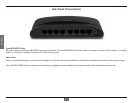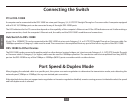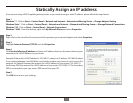
ENGLISH
22
Spanning Tree Protocol – (STP)
A bridge-based system for providing fault tolerance on networks. STP works by allowing you to implement parallel paths for network trac, and
to ensure that redundant paths are disabled when the main paths are operational and enabled if the main paths fail.
Stack
A group of network devices that are integrated to form a single logical device.
Standby Port
The port in a resilient link that will take over data transmission if the main port in the link fails.
Switch
A device that lters, forwards, and oods packets based on the packet’s destination address. The Switch learns the addresses associated with each
switch port and builds tables based on this information to be used for the switching decision.
TCP/IP
A layered set of communications protocols providing Telnet terminal emulation, FTP le transfer, and other services for communication among a
wide range of computer equipment.
Telnet
A TCP/IP application protocol that provides virtual terminal service, letting a user log in to another computer system and access a host as if the user
were connected directly to the host.
TFTP
Trivial File Transfer Protocol. Allows you to transfer les (such as software upgrades) from a remote device using your switch’s local management
capabilities.
UDP
User Datagram Protocol. An Internet standard protocol that allows an application program on one device to send a datagram to an application
program on another device.
VLAN
Virtual LAN. A group of location- and topology-independent devices that communicate as if they are on a common physical LAN.
VLT
Virtual LAN Trunk. A Switch-to-Switch link which carries trac for all the VLANs on each Switch.
VT100
A type of terminal which uses ASCII characters. VT100 screens have a text-based appearance.


















